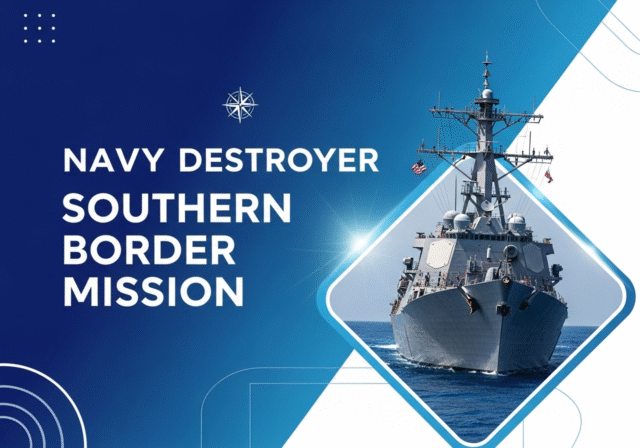The U.S. Navy’s guided-missile destroyers are usually seen in the Red Sea, Pacific, or Mediterranean. Recently, though, their presence has shifted closer to home: the southern border. This move has sparked questions, debates, and headlines. What are warships doing in an area best known for immigration and smuggling issues?
The deployment is not random. It comes as part of a wider Pentagon response to border security challenges, cartel activity, and global naval strain. With threats ranging from fentanyl flows to foreign interference, officials believe naval resources can strengthen security efforts where traditional land and air patrols are stretched thin.
In this article, you will learn why destroyers were deployed, what missions they serve, how this decision impacts U.S. defense posture, and what it means for the ongoing border debate.
Why the Navy Is Involved
Destroyers are highly versatile ships. They carry radar systems, anti-air missiles, and advanced surveillance gear. While they are built for combat at sea, they also provide intelligence and deterrence on land-adjacent missions.
The Department of Defense argues that using destroyers at the southern border enhances:
- Surveillance reach with Aegis radar and drones.
- Deterrence power against smuggling networks.
- Flexibility to support law enforcement from offshore.
The presence of destroyers is also linked to a global balancing act. With U.S. warships tied up in the Red Sea to counter Houthi threats, the Navy shifted additional vessels to ensure coverage at home.
A Timeline of Recent Deployments
In June 2025, the Pentagon announced that another destroyer would head to the southern border following a firefight in the Red Sea. Shortly after, USS Cole relieved USS Gravely in the mission area.
According to U.S. Northern Command, this rotation is designed to keep a steady naval presence without exhausting any single crew. The Navy has emphasized that border missions are not one-off moves but part of a structured deployment cycle.
USS Cole Takes Over
The USS Cole has a long history. Famously attacked in 2000 in Yemen, it has since become a symbol of resilience. Now, its assignment at the border signals the seriousness with which Washington treats this mission.
The Cole’s advanced radar systems are expected to scan for low-flying aircraft, drones, and fast boats that could attempt smuggling operations across maritime approaches to the border.
Border Security and Global Demands
Critics question whether deploying billion-dollar destroyers for border enforcement is overkill. The Navy counters that the mission supports both homeland defense and intelligence sharing.
Destroyers at the border also serve as a visible reminder of U.S. military strength. With cartels growing more sophisticated, officials believe such assets help close gaps that smaller Coast Guard cutters or patrol boats cannot.
The Bigger Picture
Sending destroyers to the southern border is not just about immigration or drugs. It reflects a shift in how the U.S. sees threats—blended between homeland and overseas. Cartel networks often connect with global suppliers. Drones, cyber tools, and smuggling routes now blur domestic and foreign dangers.
By deploying ships normally used abroad, the Pentagon signals that border security is not only a domestic issue but a strategic one.
Local and Political Reactions
Border state officials have shown mixed reactions. Some welcome the move as proof that Washington takes their concerns seriously. Others view it as militarization, raising fears about escalation near civilian areas.
Congress has also split. Supporters argue destroyers enhance deterrence. Opponents worry about costs and overstretch when the Navy already faces pressure abroad.
What the Mission Looks Like
Day-to-day operations include:
- Radar sweeps for unusual aircraft or maritime movements.
- Drone launches for extended surveillance.
- Coordination with Customs and Border Protection.
- Intelligence relays to Northern Command.
Destroyers do not directly stop migrants. Instead, they create a shield of awareness and deterrence to support agencies working on land.
Challenges and Strains
Deploying destroyers is not without risks. The Navy already faces maintenance backlogs and personnel shortages. Critics warn that assigning front-line ships to non-traditional missions may reduce readiness for global hotspots.
Fuel, logistics, and crew fatigue are also concerns. Balancing Red Sea operations, Pacific tensions, and now border patrol stretches the fleet thin.
Strategic Messaging
Beyond practical use, the deployment sends messages:
- To cartels: the U.S. is willing to escalate security.
- To rivals: homeland defense will not be neglected.
- To allies: the U.S. can operate globally and locally at once.
Such signaling is part of modern defense strategy, where perception often shapes behavior as much as action.
Looking Ahead
Will destroyers remain a fixture at the southern border? That depends on global events and political choices. If instability abroad eases, the Navy may scale down. If cartel threats intensify, deployments could expand.
Either way, the mission represents a notable shift in how America blends naval power with border security.
Operational Lessons from the Deployment
The border mission has already revealed important lessons. Destroyers bring unmatched surveillance capacity, but integration with land forces takes careful coordination. Communication pipelines between the Navy, Border Patrol, and Northern Command must remain seamless.
Another lesson is adaptability. Crews trained for high-intensity naval combat now operate in a homeland defense context. The shift has required quick learning, without compromising readiness for traditional maritime tasks.
Cost Considerations
Deploying destroyers to the border is not cheap. Each ship costs nearly $2 billion to build and tens of millions to operate annually. Fuel and maintenance add significant expenses.
Budget experts question whether those funds might be better directed to Coast Guard expansions or advanced sensor systems on land. Supporters argue that only destroyers provide the rapid flexibility and layered defense necessary against cartel innovations.
Congress continues to review long-term funding models, balancing immediate needs against strategic investment.
Comparison with Other Missions
Border operations are not the first time U.S. destroyers have taken on unusual assignments.
- During humanitarian crises, destroyers have delivered aid and medical support.
- In anti-piracy patrols near Somalia, they worked alongside smaller vessels.
- During pandemic lockdowns, they secured sea lanes critical for trade.
The southern border mission is another extension of their versatility, demonstrating how these warships adapt beyond traditional warfare.
Technology at the Forefront
Destroyers provide more than visible deterrence. Their advanced sensors extend hundreds of miles. The Aegis system allows detection of drones, low-flying aircraft, and even ballistic threats.
For border enforcement, this means early warning of aerial smuggling attempts. It also means a real-time data stream for joint operations. With AI-driven analysis, the Navy helps track unusual patterns across land, sea, and air simultaneously.
This technological edge gives agencies a level of situational awareness impossible with ground patrols alone.
Impact on Naval Crews
Serving at the southern border changes life for sailors. Instead of operating in contested international waters, they see U.S. coastlines daily. Morale remains high, but many acknowledge the mission feels unusual compared to traditional deployments.
Training schedules have also shifted. Crews rehearse coordination with Homeland Security, not just missile defense or fleet operations. These changes prepare them for an evolving world where domestic defense and overseas missions overlap.
Criticisms from Defense Analysts
Not all experts support the strategy. Some argue destroyers are overqualified for border operations. They suggest unmanned surface vessels or specialized surveillance aircraft might offer cheaper alternatives.
Others worry that assigning destroyers to the border risks creating gaps in areas like the South China Sea. Naval presence in contested waters is a cornerstone of deterrence. Pulling ships away may signal vulnerability.
Still, supporters counter that the Navy’s global fleet can absorb the rotation and that homeland defense must remain priority one.
The Cartel Factor
Cartels remain highly adaptive. They test U.S. defenses with drones, semi-submersibles, and advanced smuggling networks. Destroyers complicate their operations. High-tech radar makes surprise harder. Drone surveillance expands detection zones.
Even if destroyers do not directly intercept smugglers, their presence forces cartels to shift tactics, buying time for land forces.
Intelligence Sharing Gains
One underrated benefit of the deployment is intelligence integration. Navy sensors collect data beyond the border itself. This helps federal agencies map cross-border routes, identify smuggling corridors, and link cartel activity to overseas suppliers.
The result is a fuller intelligence picture, connecting local enforcement to global counter-narcotics operations. Destroyers thus serve as floating hubs of surveillance and information.
Symbolism and Messaging
The U.S. government knows optics matter. Images of a Navy destroyer stationed near the border resonate far beyond security circles. They signal determination to both domestic audiences and foreign rivals.
For allies, it shows Washington’s seriousness about addressing all forms of threat. For adversaries, it demonstrates that the U.S. can pivot its most advanced tools anywhere—even at its own borders.
Future Options
Looking ahead, several paths remain open:
- Maintain a rotating destroyer presence as long as cartel threats persist.
- Transition to unmanned or hybrid systems once ground agencies strengthen surveillance.
- Scale back deployments if global flashpoints demand more ships abroad.
Each choice will depend on evolving threats, political will, and defense budgets.
Conclusion
The southern border deployment of Navy destroyers is a practical experiment in blending global naval assets with local security. It highlights the Navy’s adaptability, exposes cost and coordination challenges, and shifts how America views homeland defense.
Whether temporary or long-term, the mission marks a turning point. It shows that in today’s security landscape, even warships designed for distant battles may find their place defending the homeland itself.














